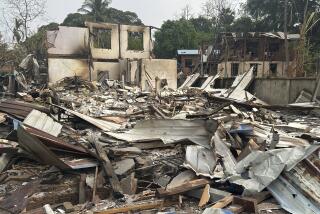Cambodian Regime Emboldened as Towns Are Retaken From Rebels : Civil war: The dramatic turnaround has strengthened Phnom Penh’s hand in talks with the opposition.
- Share via
PHNOM PENH, Cambodia — A string of battlefield victories has emboldened the Cambodian government in recent weeks and strengthened its leverage in forthcoming talks with opposition forces, according to Cambodian officials and Eastern European diplomats here.
The capture last week by Cambodian forces of the town of Thmar Pouk, about 12 miles from the Thai border, was the latest government success in its drive against three guerrilla groups based in Thailand.
Thmar Pouk, a town of about 8,000 people, had been the showpiece of the U.S.-supported Khmer People’s National Liberation Front, which had established an administrative center there as a symbol of the guerrilla presence in Cambodia. Government officials said a huge stockpile of U.S.-supplied arms was seized.
The capture of Thmar Pouk came a month after the seizure of Svay Chek, a district town north of Sisophon, which had fallen to the rebels in December.
Sok An, a vice foreign minister, said in an interview during the weekend that in addition to these successes in the northwest, Cambodian troops have fought their way to the outskirts of Pailin, a gem-mining center taken by the Khmer Rouge guerrillas last fall. He said that government forces hope to take the town, a strategic point for financial as well as military reasons, in the next few days.
The string of victories has left the government in control of virtually all Cambodian territory except for a narrow band along the Thai border. This represents a dramatic turnaround for a regime that saw large parts of its western provinces fall into rebel hands after the official withdrawal of Vietnamese troops last September.
“Frankly, we committed an error in military tactics last year,” Sok An said. “After the Vietnamese left, we continued the same troop deployment over the whole country, giving the other side an opportunity to attack small units. But we corrected our error.”
A question that has not been resolved is to what extent Vietnamese troops were involved in planning and carrying out the dry-season offensive that pushed back the guerrillas.
More than 100,000 Vietnamese troops were withdrawn from Cambodia last September, with considerable fanfare, marking the end of Vietnam’s bloody, 10-year involvement in the country. Some observers referred to the experience as “Vietnam’s Vietnam.”
Cambodian officials insist that the Vietnamese never really left, and Eastern European diplomats report Vietnamese involvement at varying levels since September. One says it has been limited to “technical advisers,” but another refers to more than 10,000 mercenary troops, including a paratroop brigade. He says these men are paid about $50 a month, or 10 times what Cambodian and Vietnamese soldiers are paid.
“The situation is more relaxed now,” Chay Saing Yun, the deputy Cambodian defense minister, told foreign reporters here. “The guerrillas have divided into small groups to avoid attacks.”
According to international aid workers who visited the border area last week, the fighting has left between 10,000 and 15,000 families homeless, and the government is asking for help in resettling them.
In Phnom Penh, a 9 p.m. curfew is still in force, but it is not strictly enforced. Chun Bun Rong, a government spokesman, said it was necessary because soldiers returning from the front were appalled at the discos and other night-life operating in the capital at a time when soldiers were being killed.
Exactly how the recent government victories might be translated into a peace settlement is not clear.
Prince Norodom Sihanouk, the deposed Cambodian leader who heads one of the three guerrilla groups, has called on Premier Hun Sen to meet with him in Bangkok, Thailand, this Saturday. But last Sunday, Hun Sen politely declined, citing ill health. This was seen in Phnom Penh as an effort by the newly confident Hun Sen to avoid being summoned to Bangkok by Sihanouk, who has jokingly called the premier a “bad boy.”
Eastern European diplomats have put more hope in recent attempts by Thailand to arrange three-party talks involving Thailand, China and Vietnam. The three countries are considered the crucial behind-the-scenes players in the Cambodian conflict, with Vietnam supporting Phnom Penh and China giving assistance to the Khmer Rouge guerrillas, who are said to have been responsible for the deaths of more than 1 million people when they ruled Cambodia from 1975 to 1979.
Relations between China and Vietnam have been slowly improving, and the Chinese plan to send a delegation to Hanoi later this month for celebrations marking the birthday of Ho Chi Minh, the founder of Vietnamese communism.
Diplomats said there have been indications that China is tiring of being internationally condemned for supporting the Khmer Rouge and may be willing to prod its proteges into a compromise. But the reports of Vietnamese troops returning to Cambodia, they said, must have made the Chinese apprehensive.
All the Cambodian factions have agreed with the five permanent members of the U.N. Security Council that Cambodia should be administered by the United Nations until after elections.
The Phnom Penh regime has also called for the creation of a supreme national council, with equal representation by the Phnom Penh government and the resistance, that would govern under U.N. authority during the transition.
Talks aimed at reaching a compromise solution to the war failed in Jakarta, Indonesia, in February because of disagreement about the council.
“After five months, people feel that the government can handle the military situation,” newspaper editor Khieu Khanarith said. “For sure, the Phnom Penh government will be negotiating from a position of strength. But we still have to find some kind of political reconciliation. We don’t want to be left behind.”
More to Read
Sign up for Essential California
The most important California stories and recommendations in your inbox every morning.
You may occasionally receive promotional content from the Los Angeles Times.













